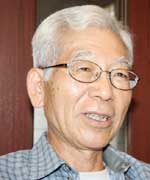"Hiroshima: A Tragedy Never To Be Repeated" by Masamoto Nasu

|
This picture book depicts the entire story of the atomic bombing, including the damage from the blast and the reconstruction that took place after the war. Shigeo Nishimura, a children's book author, created the illustrations used in the book, making detailed scenes of Hiroshima at the time of the bombing. The book includes information about the process involved in dropping the atomic bomb, the damage caused by radiation, and the proliferation of nuclear weapons since the end of World War II, along with maps, diagrams, and chronological tables. It was issued by the publisher Fukuinkan Shoten in 1995. |
Everyone in the world is an A-bomb survivor
Don't hesitate to convey Hiroshima's experience

|
Masamoto Nasu
Born in 1942 in Nishi Ward in the city of Hiroshima. The series of stories he wrote about three boys, called "Zukkoke Sanningumi," is widely popular, having sold 23 million copies. His first book about the atomic bombing of Hiroshima was "Children of the Paper Crane: The Story of Sadako Sasaki and Her Struggle With the A-Bomb Disease," published in 1984. He now lives in the city of Hofu in Yamaguchi Prefecture.
"Hiroshima: A Tragedy Never To Be Repeated" is a useful picture book for learning about the atomic bombing of Hiroshima. Since it was published in 1995, it has proven to be popular among readers, particularly for the purpose of peace education. The author of the book, the children's book author Masamoto Nasu, 68, said: "I hope readers will remember at least one scene from the book so they can help convey to others what happened in Hiroshima."
The suggestion made by a volunteer who was involved with students visiting Hiroshima on school trips persuaded Mr. Nasu to pursue the book project. "Many students tear up when they listen to the A-bomb accounts of the survivors, but they tend to see the atomic bombing as a natural disaster," the volunteer said. "Before they come to Hiroshima, I would like them to learn that the atomic bombing was a man-made disaster, but there aren't any suitable textbooks available." Mr. Nasu decided to write a book not about the individual experiences of the survivors, but a book that would depict the entire damage that the city of Hiroshima suffered.
The book was written in an objective fashion, but the tragedy of the atomic bombing is keenly communicated. "If I don't write about it, someone who knows about the day the atomic bomb was dropped, who will?" Mr. Nasu said. An A-bomb survivor himself, while writing the book he became filled with emotion. On August 6, 1945, Mr. Nasu was at home, about 3 kilometers from the hypocenter. When the bomb exploded, he was being carried on his mother's back. He was just three years old at the time, but has retained vivid memories of that day. A stream of burned and blackened people walking past his home. Half of the roof blown off the house. The colorful page of a textbook he looked at when he went into a closet to avoid the black rain that fell in the aftermath of the blast.
His first book about the atomic bomb was titled "Children of the Paper Crane: The Story of Sadako Sasaki and Her Struggle With the A-Bomb Disease," which was published in 1984. Until then, he recalled, "I was surrounded by friends from my elementary school days who had experienced the atomic bombing, and it felt too close to me to regard as a subject for my work." However, with the birth of his first son in 1981, his feelings changed. The encouragement of other children's book authors also persuaded him to write about the bombing.
Another factor that spurred him to write about the atomic bombing was his family's move from Hiroshima to the city of Hofu in Yamaguchi Prefecture in 1978. When his wife told others, "My husband experienced the atomic bombing of Hiroshima," they reacted with surprise. It elicited neither prejudice nor pity. "For them, the atomic bombing is a part of history," Mr. Nasu said. "They must have felt as if they were looking at a living fossil."
In 1995, he published "Hiroshima: A Tragedy Never To Be Repeated." Through writing the book "Children of the Paper Crane," he thought he had come to understand the atomic bombing well, but he was eager to research the event again for his new book.
"People who didn't experience the atomic bombing directly shouldn't feel reluctant about speaking out," Mr. Nasu said. "In fact, it would be impossible to hand down the experience if people don't feel free to talk about what happened in Hiroshima." In Mr. Nasu's mind, "Everyone in Japan, the A-bombed nation, is an A-bomb survivor. And everyone in the world is a survivor, too." Giving emphasis to this idea, he concluded, "Based on this point of view, we can all talk about the atomic bombing, even if you didn't experience it. I hope you will all consider yourselves survivors, too, and speak out about the atomic bombing." (Sakiko Masuda, Staff Writer)
|